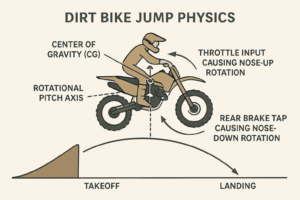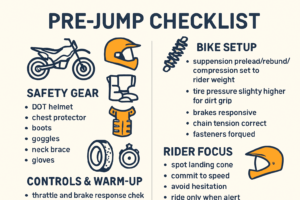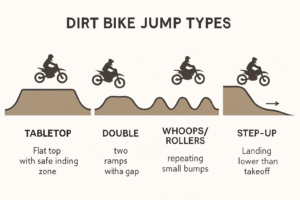The air feels so good when we throw the dirt bike sky-high. Jumping isn’t so much about going fast or being courageous, but rather an art that requires timing and control combined with an awareness of the associated risk.
This guide takes you from building confidence and preparing, through learning from mistakes, to effective after-care, a practical tool for riders of all levels, from beginner to advanced.
Оглавление
ПереключатьThe Principles of Vertical Launching with a Dirt Bike
Jumping велосипеды для бездорожья can be one of the most advanced forms of riding off-road. It is not just riding on bumpy terrain; it’s about controlled flight, having a rider tussle with momentum, hanging suspended in the air, and having to absorb impacts once the bike lands.
Differentiating Jumping in Off-Road Riding
Stability is probably the most crucial aspect in crossing trail-riding obstacles on broken ground. The jumps in motocross or freestyle riding are where the rider inputs tons of control in order to save himself from injury. The moment you leave the ramp, you are no longer riding: you are jumping into the air, flying, and landing while keeping your bike underneath you.
The Physics of Jumping
Your bike and body are in sync as a unit. The way you position yourself, how steady you are on the throttle, and how well you use your suspension join in constituting your jump experience. A motocross jump can feel really sweet or really horrible, depending on the details of the experience. Most importantly, the centre of gravity; do you lean a bit too far forward, nose dive, or too far back, free rear!? In the air, the geometry of the bike and the settings of the suspension become the two crucial elements for your stability.

Pre-Jump Preparation: Gear, Bike, and Rider Readiness
Safe jumping starts long before you ever make it to the ramp.
Необходимые средства безопасности
The foam-padded, Одобрено DOT helmets go right to the top of the list, followed by chest protectors, robust boots, goggles, and neck brace; injuries from motocross jumping put on much more load on the body than casual riding, so the protective gear should consist of extra padding and impact resistance.
Thinking of avoiding injury in the event of a crash is not enough; rather, the equipment also has to impart comfort and instil confidence within the rider.
Bike Setup for Jumping
It should be adjusted for the extra forces of take-off and landing: suspension preload, rebound, and compression according to weight and type of riding. Tire pressures should be on the high side to aid dirt grip, but should always allow allow the early detection of instant response to both brakes and throttle.
Rider Fitness and Focus
Your core strength and fast reactions can make a world of difference to your performance, while on a psychological basis, you want to go into your jump committed, without an ounce of hesitation.
You should be able to spot your landing zone and commit to the jump without second-guessing yourself.
Warm-up and Practice Techniques
Initially, you’ll want to do 5-10 minutes of light cardio to get the heart rate up; running or jumping jacks will do it. Next, involve yourself in some dynamic stretches aimed at your legs, hips, and shoulders. On the bike: slow-speed balance drills, very short bunny hops, and small roll-over bumps will “open up” your body and fine-tune throttle and brake response. These five drills can be used to get your muscles activated and ready for action in anticipation of bigger jumps.

Types of Dirt Bike Jumps
Knowing how to identify the different types of big dirt bike jumps will keep your learning path more assured.

Tabletop
The safest jump for beginners, with a flat landing zone so you don’t risk falling into a gap if you come up short.
Double
Two ramps with a gap between them. You must carry enough speed to clear the gap completely, or you risk landing dangerously in the middle.
Whoops and Rollers
A series of small bumps that challenge your rhythm and speed control. Beginners can whoop dirt bikes and roll through them, and advanced riders can skim over the tops.
Step-Up and Step-Down
A step-up throws you up higher; a step-down sends you down lower. Both require precise throttle control that ensures smooth landings.
Step-By-Step: How to Jump a Dirt Bike Properly
How do I make a dirt bike jump? This type of step-by-step learning helps you to get the right confidence to jump on the dirt bike.
1. Speed on Approach
The approach speed greatly depends on the kind of jump and the power of your bike. If you are slow, you will “case” the landing; if you are too fast, you will overshoot the landing. Keep building up your speed, starting small to get the feel.
2. Stand Up and Centre Weight
Using attack position, elbows out, knees bent, and weight with the centre of the bike, this position will keep you stable and ready for take-off.
3. Smooth Throttle through the Lip
Don’t change your throttle suddenly! Set a little preload on the suspension with your weight by pushing down just before the lip with the throttle, and let rebounding do its job to grant you controllable lift.
4. Control in Mid-Air
Arms and knees bent, absorb shock and make small mid-air adjustments as necessary. Stay loose and balanced.
5. Land
If the front end is coming up, lightly tap the rear brake; find your landing, bend your knees to absorb impact, and roll on the throttle smoothly.
Skill-Level Recommendations
Here we discuss different levels of big jumps on dirt bikes in accordance with skill level:
Начинающие
Start on tabletop jumps and easy rollers: low ones. The first few rides focus less on height and more on smoothness. Try to make the feeling of simply rolling off the lip and landing like flowing water, or easy on the bike. In this case, just relax and look for the landing.
Intermediates
Once you can land smoothly on the bike most of the time, without a heavy impact, start practicing doubles and small step-ups. Use a touch of throttle and gentle braking to control the bike’s pitch while in the air.
Start getting comfortable landing on surfaces that are a bit angled; this will get you ready for advanced tracks.
Advanced
Now it is time to whip out a handful of the bigger jumps and harder combos. Perfect the scrub for speed, whip for style, and link together multiple jumps, maintaining speed. Finally, practice as many terrain conditions as possible to cement your adaptability.
Advanced Jumping Tips
Want to level up your jumping skills? Let’s give you some important and useful tips for advanced jumping:
Scrubbing and Whipping
Scrubbing decreases the air time, allowing for a more direct landing and speeding up acceleration. Whipping enhances the jump and facilitates an angle at landing. Do not attempt to practice until your basic jumps are mastered.
Mid-air Adjustments
The throttle may be twisted to raise the nose when the front is dropping, or the back brake may be tapped to bring the nose down a little while the rear is dropping too low.
Trail vs. Track Jumping
Track jumps are also nice and predictable and pretty safer when learning. Trail jumps may not be apparent as hazards, so make sure you check your landing zone before really jumping for it.
Common Errors In Jumping And Solutions
Mistakes do happen, but knowing how to deal with them can mean the difference between safe jumping and an injury.
Chopping the Throttle on Takeoff
This causes instability. The fix? Stay committed with smooth throttle control.
Leaning Too Far Back or Forward
This throws off your balance. Keep your weight centred.
Landing Flat or Nose First
One of the fastest ways to get hurt. Learn to break-tap and preload properly.
Overjumping
Gauge your speed carefully. Practice on safe jumps before trying longer gaps.
Practice Safe
Start small. Gradual is the best way to practice to improve as much as possible.
Get Smaller, Focus on Technique
First, use tabletop jumps or small rollers to get the position for your body, take-throttle control, and landing spotting technique before trying big jumps.
Videorecord yourself
The two most important items that shape your practice: Record your jumps and review your body position relative to your timing.
Ride with experienced jumpers or a coach for real-time feedback.
Jumping Conditions Risk Factors
Conditions are just as much about technique as they are in place. Loose dust, mud, or rocks can all easily cause unpredictable landings. Wet will also take traction, and wind can work against you in flight. Your condition also matters; any fatigue and distractions will multiply mistakes, so ride only when you are alert.
Terrain is very important in respect to your bike when it takes off or lands. With settings gone astray, there is a very real chance of losing control or even crashing. Continue to mold your technique to suit the conditions.
Wet Terrain: Enter the jump with a bit less speed than usual, and keep your throttle smooth to avoid wheel spin. Move your body slightly more toward the center to help avoid slides.
Soft Terrain: Use a little more throttle in the approach to avoid any bogging or squeezing, and just be prepared for a marginally slower feel for the rebound upon landing.
Hard Terrain: Expect less traction; arrive at the jump under control, avoid aggressive braking just before the jump to remain balanced.
Emergency Situations and How To Handle Them
If you lose balance in mid-air, remain as cool as possible; stiffening the body just causes more injury. In case of an actual fall, clear the bike away from you and roll into the fall, lessening its striking force. These strategies won’t make the crash any safer, but should mitigate some level of injury.
Jumping Improvement Exercises and Drills
Grasps of smooth throttle application on flat surfaces. Timing lift with suspension rebound. Off the bike, develop the core with planks, squats, and balance board exercises. If you get to a foam pit or an airbag, they are perfect places to land safely.
Bike Care for Jump Performance
Your bike takes a lot of abuse while jumping. Hence, regular maintenance becomes necessary for safety and performance.
The first maintenance will be on suspension. Oil leakage and seals should be looked into. What changes in the damping response? Inspect the spring carefully, and service your fork and shock absorbers regularly. Neglecting this can disrupt your suspension, affecting both takeoff performance and landing stability.
After the occurrence of hard landings, check for cracks or bends in the frame and subframe. Watch for paint flaking around the welds, as this is often an early sign of structural stress.
Brakes function like your control system in the air and on the ground. Weak or spongy brakes limit pitch correction abilities when required. Clean and bleed brake lines and replace worn pads to make sure your brakes are nice and sharp.
Regularly check chains. Clean and lubricate it after every ride, adjusting tension to ensure it is neither loose nor tight. This will prevent sudden chain failure under huge landing forces.
All bolts and fasteners must be tight. Jumps send everything on the bike into a vibrating state, so any loose hardware will fail catastrophically. A quick check before the ride could save you huge trouble.
Real-life Example
Let’s say you’re a beginner aiming to progress in three weeks. In week one, you focus only on small tabletops, never going more than a foot off the ground. And you work on staying centred and spotting your landing by week two. Now, week two would give you more speed while starting to preload the suspension for extra lift. In week three, you will have an easy tabletop to clear and will be practising a small double under supervision from an experienced rider.
Dirt Bike Brands Known for Jumping Performance
Yamaha YZ125 and YZ250F are by far some of the lightest, most manageable. KTM’s SX series has advanced suspension primarily geared toward performing jumps. The Honda CRF series of bikes is forgiving and durable. BSEMotors and SSR Motorsports can offer great, jump-ready options to entry-level riders on a budget.
BSEMotors Dirt Bikes Jump-Ready for Everybody
BSEMotors is one of the most famous makers of dirt bikes at an affordable price, with reliable, strong suspensions, and light enough geometry for practising jumps without breaking the bank. It braves repeated takes and landings, the requirement during the preliminaries.
Часто задаваемые вопросы
Is jumping safe for a beginner?
Really, it is, if everything is controlled: big start, little jump; and all protection.
Do I need a special bike?
Not really, although a motocross bike with good suspension will soften the landing.
What is the best jump to start with?
Tabletop jumps are great for most-learning without stress.
Final Words
A dirt bike throw is among the most exhilarating things to do on two wheels. On the flipside, it demands discipline, patience, and a strength of purpose towards safety. Just keep it simple; slowly learn to master your form and then move on at a pace that will empower you without subjecting you to risking slightly too soon. Your bike should be kept tuned and in the best form that it can possibly be so that it doesn’t complain whilst being taken for walks, launching and landing. Respect the terrain, the weather, and your own limits.
